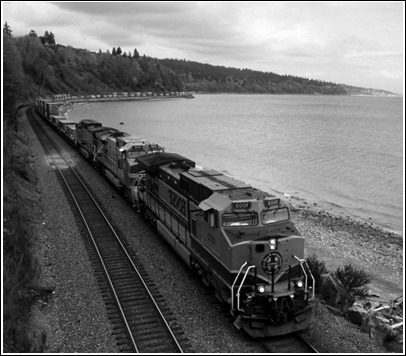|
|||||||||||||
| archives | submissions | news | (dis)likes | ||||||||||
 |
|||
 |
|||
|
The Train, Stopped |
|||
|
Lot 613 |
|||
|
The Way There and the Way Back |
|||
|
Vanishing Point |
|||
|
Kevin Brockmeier |
|||
|
Jodee Stanley is the editor of Ninth Letter at the University of Illinois, Urbana-Champaign. Her fiction has appeared recently or is forthcoming in 580 Split, Margin, Electric Velocipede, and elsewhere. She lives with her daughter in Urbana, Illinois. |
|||

 |
 |
|
Photo by Sean Carman |
Sometimes there is a freight train stopped on the tracks. The tracks split the town, dividing it into one half and the other. On the one side, there is school. On the other, there is the little green park and your grandmother’s house.
There are two ways to get around a stopped train. Over, and under.
You can go over by the bridge. The bridge is very far away, blocks away, and when you are nine you prefer not to walk that distance. Plus, the truth now, the bridge is high and gives you vertigo. The bridge is really made for cars but there is a walkway along one side with a railing that is steel but still looks flimsy. The railing triggers a temptation to jump, which you find disconcerting, a new sensation that still terrifies you, that will soon lose its novelty but will never completely desert you, even in thirty years when you press your sweaty face against the thick windows of the Sears Tower Skydeck and push, gently, with your palms.
The other way around the train is to crawl under. Who would crawl under a train? train could fire up and roll at any second. A train could also stand still for ten minutes, or twenty, or thirty. Ten minutes seem like thirty, or an hour, or a day, when you are nine years old and hungry and there is peanut butter on the other side. But the train could roll at any second.
When you are not alone, you will generally wait for the train to move on. There are ways to pass the time with company: talking, tic tac toe, hangman, talking. You can sit in the grass alongside the tracks and pull blades, knot them into rings, flick them at the other person.
But you are alone.
You could wait for the train to move, but there is no telling how long it will sit there on the tracks. The engine is a dot on one horizon, the caboose not even visible on the other. The train is like a graffitied wall before you. You feel panic welling up. Recalling it thirty years later, you still feel the shortness of breath: get out, get out, get out. Weak daylight grays the shadows under the boxcars, making the space beneath not uninviting. But the train could roll. It could roll now. It could roll in five minutes. The longer you wait, indecisive, the greater the chances it will roll. And you can’t wait. The wait is forever. You can’t.
So you go under the train.
The muscles in your back and neck tighten and you don’t breathe and it’s so much farther to crawl than it looks. The shadows are black when you get under there and it smells of metal and oil and dust, and the tracks are greasy, the ties are dirty and splintery and there’s gravel that sticks to your hands. Being under the train is like being underwater. Everything’s slow and silent, the silence predicting the inevitable giant huffing of the engine fire, and once there were two trains stopped and you went under them both. And once you lost your tortoiseshell headband and went back for it because it was new, and your throat was closed while you did it as you thought stupid stupid, that you were going to die.
Nobody knew you went under. Nobody saw. It is your one secret you never told. You went under, and under, again, never able to wait, each time playing another chip of luck, and the train never smashed your head, the train never rolled, and in your dreams, now, you still go under.
